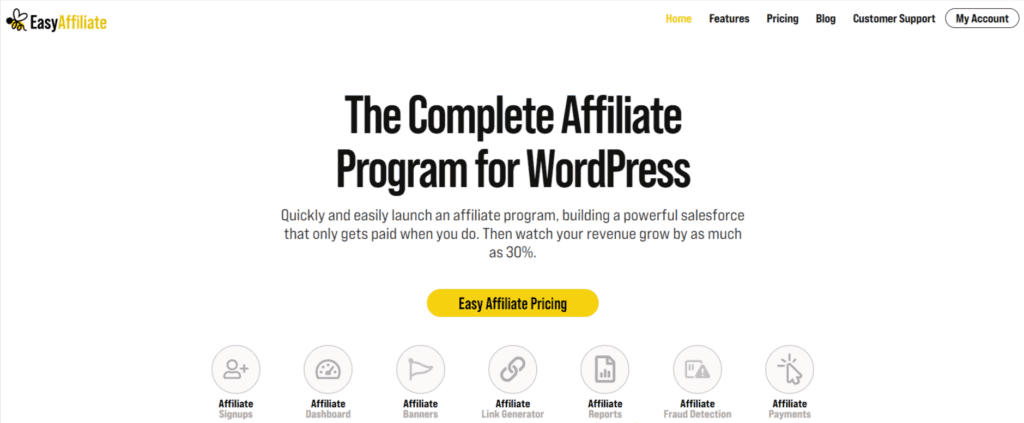Table of Contents
Affiliate marketing is where the magic happens for businesses and publishers alike, both aiming for a win-win: shared profits and expanding their customer base.
It's an attractive avenue for growth, but let's be real – those headline-grabbing success stories? They're not one-size-fits-all.
Achieving standout success in affiliate marketing is more about smart strategy and less about hoping for a lucky break.
It's about peeling back the layers of those success stories to understand the core principles at play and then tailoring those insights to fit your unique strategy.
For small business owners venturing into or scaling up their affiliate programs, this means taking a step back, assessing the landscape, and adopting practices that have proven effective time and again.
It's not just about what you're doing, but how you're doing it. And that's what we're here to explore – the ‘how' that can turn your affiliate marketing efforts from good to great.
Thankfully, by looking at other successful programs, you can identify characteristics they have in common and incorporate them into your own strategy.
This piece will unpack six essential traits shared by standout affiliate marketing initiatives. We're going to break down each trait, look into its significance, and guide you on integrating these elements into your strategy.
Let's get straight to the heart of it!
1. Quality Affiliates
Affiliates are your representatives, linking you to your customers and leads. They promote your products or services to their own unique audiences, expanding your reach by exposing your business to new prospects you might not otherwise reach.
However, not all partnerships are bound for success. Quality affiliates are knowledgeable about your products and find creative ways to sell them.
They consistently produce valuable and engaging content for their audiences, and they’re willing to learn and adapt as you evaluate and modify campaigns.
On the other hand, low-quality affiliates make little effort to show off your products. They publish content sporadically and without thought to their audiences' needs or interests, and may even unintentionally spread misinformation about your brand. In other cases, they might simply be a poor fit for your business' identity or values.
Pro-Tips:
- Regularly assess the performance of your affiliates and your engagement with your partners through the analytical tools provided in your admin panel. This data is invaluable in understanding who is truly extending your reach effectively.
- Develop your relationships and keep your affiliates happy by providing helpful tools, financial incentives, and a sense of community. This not only boosts their performance but also strengthens their loyalty to your brand.
2. Products That Provide Value to Customers
Successful sellers promote products they believe in. If you want your affiliate marketing program to succeed, you need to do your part and provide a valuable item that people actually want to buy.
Understanding the problems and challenges your customers face is key to creating products they'll value. Sometimes, you can solve challenges your customers don’t even know they have. These products surprise and delight. They can revolutionize an industry.
When Apple recreated the iPhone, it didn’t start with what its competitors were already doing. Michael Hyatt describes it as “not only as good as Apple could make it, but as good as Apple could imagine it.”
Pro-Tips:
- Get to the root of what your customers really need. Use this insight to shape your product development, pushing you to not only meet but anticipate customer desires.
- Think outside the box in product innovation, much like Apple did with the iPhone. It's not about following trends but setting them by imagining and delivering beyond the expected.
3. Attention to Key Performance Indicators (KPIs)
KPIs provide you with information about the effectiveness of individual campaigns. They also let you know how your business is performing overall.
These metrics include information such as:
- Click-Through Rate (CTR). The number of users who click on affiliate links and proceed to your website.
- Conversion Rate. Percentage of affiliate traffic you’re converting into buying customers.
- Cost Per Click. How much you spend on average for every click-through to your website.
This information is hard data. It’s an accurate picture of how your affiliate campaigns are performing. KPIs help you measure growth and identify trouble spots before they become costly problems.
KPIs are a crucial reality check, and successful marketers pay close attention to them. You can stay informed and proactive with reliable tracking and reporting via Easy Affiliate.

Pro-Tip:
- Leverage Easy Affiliate's WordPress plugin for an integrated view of your KPIs, making it easier to track performance and adjust strategies promptly.
- Regular KPI reviews can preempt issues, allowing for timely adjustments that keep your campaigns on the path to success.
4. A Thriving Affiliate Community
Creating an affiliate community around your brand or business provides a space where your partners can engage with you and each other. This generates loyalty and enthusiasm while also organically building momentum and fostering positive experiences.
In addition to helping set your partners up for success and enabling them to get to know one another, more exposure to your brand should help affiliates represent your business more accurately to their audiences, too.
Pro-Tips:
Here are a few tips for building a thriving affiliate community:
- Encourage knowledge sharing and collaboration among affiliates. This can spark innovative promotional strategies and strengthen community bonds.
- Take advantage of accessible communication tools to increase engagement and gather feedback.
- Utilize forums and social platforms to facilitate discussions and feedback. This engagement can lead to valuable insights and foster a supportive network.
5. Patience While You Wait for Growth
Any kind of growth takes patience, and developing a successful affiliate marketing program is no different. Affiliates require time to learn how best to share your product with their followers.
They may also need a few months to develop and publish content, refine calls to action (CTAs), and present your brand in ways that motivate clicks.
Pro-Tips:
- Provide your affiliates with comprehensive tools and resources to aid their promotional efforts, ensuring they have everything they need to succeed.
- Keep a close eye on your KPIs to measure the impact of your affiliates' content, allowing you to identify what works best and tailor future strategies accordingly.
6. Profitability
Profitability is usually the first characteristic we think of when measuring success, but it's listed last here for a reason. That's because profitability often comes after a lot of hard work, thoughtful decisions, preparation, and maybe a bit of luck.
Quality affiliates, valuable products, thriving communities, and even patience lead to profitability. In the vast majority of cases, you have to nurture the other characteristics on this list before you turn your attention to money.
Pro-Tips:
Here are a few areas to tweak for increased profitability:
- Manage product costs to accommodate fair commission payouts at prices customers are willing to pay. This may take some testing, so track your sales numbers and evaluate.
- Determine affiliate commission rates by researching your competition and calculating a target profit margin.
- Get noticed, recruit more affiliates, and build awareness through advertising.
- Boost immediate sales with coupons.
As your business generates revenue, you can monitor and adjust the factors that impact your profit margins.
Conclusion
Creating a successful affiliate program takes work. While the definition of success may vary between brands, there are definite attributes you can develop and incorporate into your own strategy to unlock your earning potential and increase affiliate and customer satisfaction.
Remember, the essence of a thriving affiliate marketing strategy lies in recognizing and nurturing these key characteristics within your own setup.
In this post, we’ve covered six key characteristics successful affiliate marketing programs share:
- Quality affiliates who consistently produce relevant and engaging content.
- Products that provide value to your customer base.
- Attention to KPIs so you can identify areas of potential improvement and growth.
- A thriving affiliate community that fosters loyalty and provides resources and motivation.
- Patience while you wait for growth.
- Profitability achieved by supporting your affiliates and optimizing your commission rates.
As you move forward, take these insights and weave them into the fabric of your affiliate marketing program.
More importantly, don't underestimate the power of using the right tools.
Easy Affiliate emerges as a cornerstone for businesses aiming to sculpt an impactful affiliate marketing program. It's designed with you, the small business owner, in mind, streamlining the complexities of managing affiliates into a manageable, user-friendly experience.
Easy Affiliate equips you with a suite of tools that empower you to recruit, manage, and collaborate with your affiliates effectively.
Ready to elevate your affiliate marketing game? Take these actionable insights and start implementing them today.
The journey to a more successful program begins with these strategic steps. Let's make it happen!
Do you have questions about how to build a successful affiliate marketing program? Let us know in the comments section below!
If you liked this post, be sure to follow us on Twitter, Facebook, and LinkedIn! And don't forget to subscribe in the box below.






Leave a Reply